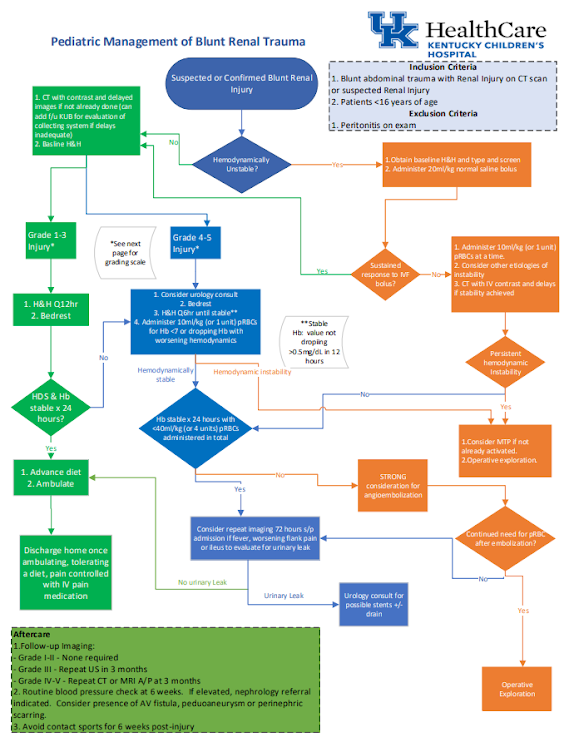Blunt Genitourinary Trauma Algorithm
Introduction
·
Trauma to the genitourinary (GU) tract is present in approximately 10% of
all injuries.
·
Children are at increased risk of renal injury
from blunt trauma due to decreased perirenal fat, weaker abdominal musculature,
and less ossified thoracic cage.
Blunt
Renal Trauma
·
The kidneys are the most commonly injured organs in the GU tract.
·
Gross
hematuria mandates further workup of the GU tract
– prompt surgical consultation is warranted.
·
If renal trauma suspected, CT abdomen and
pelvis with IV contrast and delayed images (excretory phase) should be
obtained.
·
Management depends on hemodynamic stability of the patient and grade of injury (see attached algorithm)
·
Most renal
injuries do not require an operation in a stable patient with the exception of those who
have evidence of urinary leak.
·
Please refer to the attached algorithm for
complete details.
AAST Kidney Injury
Scoring Scale
Bladder
Trauma
·
Extraperitoneal bladder rupture is most commonly
associated with pelvic fracture.
·
Intraperitoneal bladder rupture is a result of
blunt lower abdominal force on a
full bladder.
·
Classic physical
findings of bladder rupture
include suprapubic pain, hematuria, and inability to void.
·
If bladder trauma suspected, CT cystogram should be
obtained with contrast used to actively fill the bladder through the
Foley catheter (rather than just clamping the Foley catheter and waiting)
·
Extraperitoneal bladder rupture is generally
managed with Foley catheter drainage.
·
Intraperitoneal bladder rupture requires
immediate surgical intervention.
·
Other considerations for operative management
include:
o If
the patient is going to the operating room with another team (IE- ortho team
for pelvis fracture)
o Presence
of bone or foreign body in the bladder
o Bladder
Neck injury
o Concomitant
vaginal or rectal injury
o Extraperitoneal
injury that hasn’t healed with Foley catheter drainage
·
It is acceptable to attempt Foley catheter
placement x1 before calling urology team.
Urethral
Trauma
·
Urethral injuries are usually due to blunt
trauma and are associated with pelvic fracture or straddle-type injuries.
·
Injury of the bulbar urethra is most common.
Injuries of the female urethra are rare.
If present they require cystoscopy to rule out other injuries.
·
Physical findings of blood at the meatus, perineal hematoma or extensive laceration, a high riding
prostate, or a large hematoma found on rectal exam mandates a retrograde
urethrogram prior to insertion of a
Foley catheter.
·
Definitive diagnosis is via retrograde
urethrogram (RUG)
·
Management requires OR (suprapubic diversion vs
endoscopic placement of Foley)
References:
1.
Hagedorn JC, Fox N, Ellison JS, et al. Pediatric Blunt Renal Trauma Practice
management Guidelines: Collaboration between the Eastern Association for the
Surgery of Trauma and the Pediatric Trauma Society. J
Trauma Acute Care Surg 2019; 86:
916-25. doi: 10.1097/TA.0000000000002209
2.
Coccolini F, Moore
EE, Kluger Y, et al. Kidney and
uro-trauma: WSES-AAST guidelines. World
J Emerg Surg. 2019;14:54. doi: 10.1186/s13017-019-0274-x
3.
Serafetinides E,
Kitrey ND, Djakovic N, et al. Review of
the current management of upper urinary tract injuries by the EAU Trauma
Guidelines Panel. Eur Urol. 2015;67:930-6.
doi: 10.1016/j.eururo.2014.12.034.
4.
Coccolini, Federico
& Moore, Ernest & Kluger, Yoram & Biffl, Walter & Leppäniemi,
Ari & Matsumura, Yosuke & Kim, Fernando & Peitzman, Andrew &
Fraga, Gustavo & Sartelli, Massimo & Ansaloni, Luca & Augustin,
Goran & Kirkpatrick, Andrew & Abu-Zidan, Fikri & Wani, Imitiaz
& Weber, Dieter & Pikoulis, Emmanouil & Larrea, Martha &
Arvieux, Catherine & Catena, Fausto. (2019). Kidney and uro-trauma:
WSES-AAST guidelines. World Journal of Emergency Surgery. 14.
10.1186/s13017-019-0274-x.
Disclaimer
These guidelines are not intended as a directive or to
present a definitive statement of the applicable standard of patient care. They are offered as an approach for quality
assurance and risk management and are subject to (1) revision as warranted by
the continuing evaluation of technology and practice; (2) the overall individual
professional discretion and judgment of the treating provider in a given patient
circumstance; and (3) the patient’s willingness to follow the recommended treatment.

